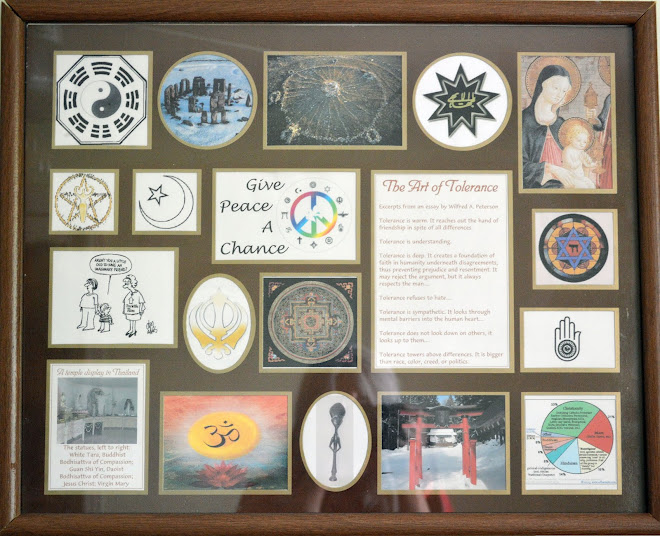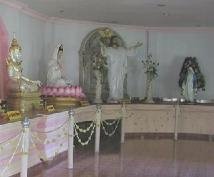Mandala: http://en.wikipedia.org/wiki/Mandala
In practice, mandala has become a generic term for any plan, chart or geometric pattern that represents the cosmos metaphysically or symbolically, a microcosm of the universe from the human perspective.

Anglo-Saxon & Ancient Scandinavian
The characters of the Anglo-Saxon alphabet (called Runes) were often carved into geometric designs. These were occasionally created to represent the universe, but most often was used in creating magic spells or designs of protection. Similar designs are called Pennsylvania Dutch Hex Signs which once were painted onto barns and houses for good luck and protection
Buddhist and Hindu
http://www.answers.com/topic/mandala
In Tantric Hinduism and Buddhism (see Vajrayana), a diagram representing the universe, used in sacred rites and as an instrument of meditation. The mandala serves as a collection point for universal forces. By mentally "entering" the mandala and moving toward its centre, one is guided through the cosmic processes of disintegration and reintegration. Mandalas may be painted on paper or cloth, drawn on the ground, or fashioned of bronze or stone. Two types of mandalas represent different aspects of the universe: the garbha-dhatu ("womb world"), in which the movement is from one to the many, and the vajra-dhatu ("diamond world"), from the many into one.
Christian
http://dragon_azure.tripod.com/UoA/Med-Arch-Rose-Window.html
What is the meaning behind a rose window? Many contemporary authors wax on about Jungian psychology and the rose window as a mandala, which represents the "expression of human aspiration towards wholeness and coherence." Mandalas have existed in Eastern religion and philosophy for centuries, and in modern thinking, the medieval rose window serves much the same purpose. The rose window operates on many levels: spiritual, meditative, and emotional. Abbot Suger's observations underscore how deep an emotional and spiritual chord is struck by the play of light that passes through the glass. The instructional aspect of rose windows is plainly visible by the subjects chosen for display in each petal--the medieval calendar year, the virtues and vices, the saints, etc.
In much the same way the center of Eastern mandalas depict the "godhead" or divine aspect of the world, so do rose windows. Typically Christ or the Virgin and Christ are found in the central rosette of most windows. In eastern philosophy, there are many paths to reach the divine, and these are represented by "gates" at the cardinal points of the mandala. By the same token, saints depicted in the petals of a rose window can be seen as intermediaries (or paths) to Christ.
Daoist
I suppose the taiji symbol (yin/yang) could be considered a Daoist mandala since on one level it represents heaven (yang) and earth (yin). However, the He Tu (or Ho Tu) diagram might serve as a mandala as well. The five white center dots that form a circle represent heaven, the ten black center dots that form a square represent earth, and the sets of black and white dots around the outside represent the five energy phases that create all things that exist between heaven and earth.
Greek Ancient
http://www.crystalinks.com/labyrinths.html
A labyrinth is an ancient symbol that relates to wholeness. It combines the imagery of the circle and the spiral into a meandering but purposeful path. It represents a journey to our own center and back again out into the world. Labyrinths have long been used as meditation and prayer tools. A labyrinth is an archetype with which we can have a direct experience.
A labyrinth contains non-verbal, implicate geometric and numerological prompts that create a multi-dimensional holographic field. These unseen patterns are referred to as sacred geometry. They allegedly reveal the presence of a cosmic order as they interface the world of material form and the subtler realms of higher consciousness.
Hindu
See Buddhist above.
Jewish
http://www.aloha.net/~morty/jewish.htm#USE%20OF%20THE%20SHIVITI
"Shiviti" comes from the sentence, "I have set (shiviti) the Lord before me always." Looking at a Shiviti is Name-gazing; it is akin to ikon-gazing: concentrating on the symbol of the Deity with a focused gaze, until the distance between inside and outside becomes obliterated, and what was on the outside (the shiviti) becomes internalized. Looking at the Shiviti we view the world from God's vantage point. Chesed, God's right hand, as it were, is on our right, not opposite our left hand, as it would be if we were facing God. This is connected to God's words to Moses, "You shall see my back, but my face is not to be seen." So one walks, as it were, into the YHVH, facing in the same direction, becoming one with it.
The Name is written in such a way, top to bottom, rather than right to left, to create a hierarchy and also a figure: Yud is the head; the upper Heh, the arms and shoulders; Vav, the heart, spine and genitals; and the lower Heh, the legs, and pelvis. These are the four levels: The top of the Yud is Keter and the rest of it is Chochmah, the two Heh's are Binah and Malkhut. The Vav contains the sephirot Chesed, Gevurah, Tiferet, Netzach, Hod and Yesod.
In prayer, one sits in front of the Shiviti, and stares at it to ascend to God's Presence, and then to descend. The four letters represent the parts of the prayer service: In the morning prayer, one looks at the lower Heh during the Birkhat HaShachar, the pening blessings which address the world of Assiyah, the world of our bodies, our environment; getting ready in Assiyah requires doing an inventory of the body: What tensions are my muscles holding on to, what messages is my body telling me that I have been too busy to pay attention to? To place oneself in the presence of God is to let the body out from any compulsion that it is under.
Muslim
http://www.muslimheritage.com/topics/default.cfm?ArticleID=547
Some fundamentals that were brought about by the Holy Qur'an similarly gave rise to the form of the mosque. Of these fundamentals, the most important one is "Arsh", namely "the Throne."
The literal meaning of the Throne is: altitude, high place, ceiling, cover, the tent and it is used in the Qur'an and in the Hadiths (the sayings of the Prophet Muhammad) as "Divine Sovereignty, Dignity and the Throne" (Devellioglu 1970: Ars.; Golpinarli 1977: Ars, 1989:101; Akay 1991: Ars; DIA: Ars; IA: Kursu).
Alone with the concept of the Throne, it is necessary to mention the iconographical concept of "mandala" which is used in various ways in Turkish architecture and which I suppose to have a close relationship with the Throne.
The shape of the cosmogram called mandala in architecture and handcrafts, consists of a circle and a square, one within the other. While the circle represents God, cosmos, mystical life, eternity, the world of eternity and esoterical concepts; the square represents the world, material life, worldly life and all exoterical concepts. This was commonly used in
The full meanings that the square and the circle of the mandala include, both separately and together, is in accordance with the philosophy of Islam. The plan with four iwans and a central courtyard has been interpreted as an image of the cosmos. This plan has a very long past; it has been identified with the diagram of mandala and has been extensively applied in architecture for centuries (Ogel 1986: 59-84; 1994: 63-115). The concept of mandala which takes place in pre-Islamic Turkic beliefs and traditions, has been united and integrated with the concept of the Throne, which has played a significant role in the formation of religious architecture after Islam.
Native American
Sandpainting
http://www.penfieldgallery.com/sand.shtml
The Navajo word for sandpaintings means "place where the gods come and go." The sandpainting has been used for centuries in religious rituals, including healing ceremonies performed by Navajo medicine men. A sandpainting for a ceremony is made on the ground in the ceremonial hogan and destroyed at the end of the ritual. In order to preserve this long-standing tradition, in the late 1940's Navajos began to create permanent sandpaintings, changing the design slightly to protect the religious significance when these paintings were shown publicly. Pictorial sandpaintings which reflect the Navajo environment and lifestyle are also made. Today sandpaintings are made by slowly trickling sand through the hand onto epoxy-covered particle boards, using sand made from naturally colored crushed rock, stone, and minerals for the different shades and colors. The sandpainting is intended to be hung within a frame or by attaching picture hangers to the back of the board. [These sandpaintings are often of a mandala-type design in which the shapes and colors in each quadrant are mirror-images of the others. ~M~]
Medicine Wheel
http://www.sacredart.com/medicinewheel.html
The Medicine Wheel is a symbol of all creation, of all races of human beings, birds, fish, animals, trees, and stones. It's in the shape of a wheel. The circle shape represents the earth, the sun, the moon, the cycles of life, the seasons, and day to night. Movement around the outside of the Medicine Wheel is in a clockwise direction, the rotation path of mother earth. At the center of the wheel (the hub) is the Creator, who sits in perfect balance. Outside the center, there is an inner circle representing the Old Woman (the earth), Father Sun, Grandmother Moon, and the four elements. Four distinct colors, set in the four directions, lay on the perimeter, separated by beads representing the moon's cycles. Leather, laid from the perimeter, in straight lines, to the center (the spokes of the wheel) represent spiritual paths leading us to the center, to perfect balance, to the Creator. The meaning of the number four, as it is in Native American life, is evident in the Medicine Wheel. 4 = four directions + four seasons + four elements (earth, air, water and fire) + the four races of human being.
Scandinavian Ancient
See Anglo-Saxon above.
Shinto
http://www.kimbellart.org/database/index.cfm?detail=yes&ID=AP%201982.02
(Visit link to see picture.)
This simple composition of figures placed against a dark ground is an outstanding example of medieval Japanese Shinto mandala. The top part of the scroll contains small figures of a thunder god, a Buddhist priest, a deer, and a pagoda; the bottom register contains two lion dogs facing each other; and the center section contains four figures. The large central figure of a non-Japanese male dressed in secular costume is identified as an Indian, Vimalakirti, called Yuima in Japanese. Below him, a male in court robes is flanked by a secondary nobleman and a Buddhist priest. Vimalakirti was a layman who is said to have lived in north central
The combination of Buddhist and Shinto figures in the same scene is an established convention for a Shinto mandala. When the native Shinto faith reached an accommodation with Buddhism, a foreign religion, the two faiths united Buddhas with native gods in a syncretic whole; indigenous Japanese gods were identified with Buddhist counterparts. In this painting, the figure dressed in court robes below Vimalakirti is thought to be his Shinto counterpart.
Wiccan
http://www.llewellyn.com/bookstore/article.php?id=793
Take, for example, the pentacle, the encircled five-pointed star. This is a neopagan mandala that expresses the wisdom of the elements and their relationship to one another. In this way, the pentacle is not only a magical tool, but a teacher.
~~~~~~~~~~~~~~~~~~~~~~~~~~~~~~~~~~~~~~~~~~~~~~~~~
Here are some mandalas for you: World Mandalas book
Book Description
Beautiful and enlightening, these classical mandalas include rose window designs from the cathedrals of




